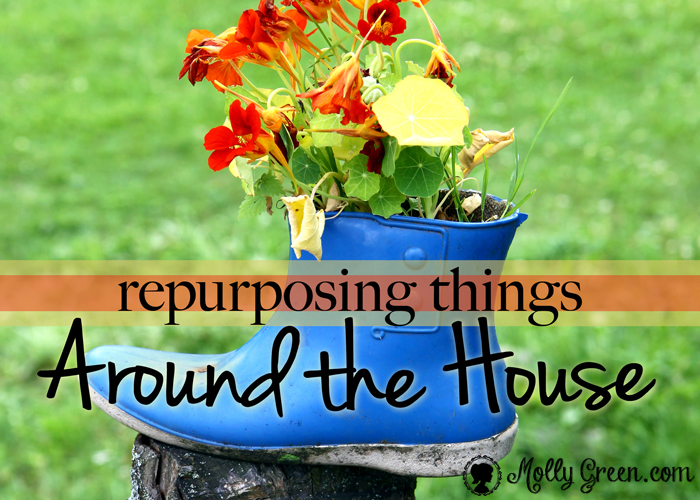By Patricia Hunter
One night several years ago, a young friend and his wife were home alone without their three young children when they decided to entertain themselves by creating and recording a song with their children’s toy instruments. “When you’re broke, you use what you’ve got,” my friend wrote when he posted the video online for our amusement.
Making music with toy instruments is an extreme example, but using what we’ve got isn’t just inspiration for when we’re broke. It’s good stewardship of our resources. And being content to use what we’ve got and avoid waste—whether it’s time, money, talents, or possessions—is at the heart of what it means to practice frugal living.
We can’t use what we’ve got if we don’t know or remember what’s in the back of the refrigerator and pantry or stored in closets. So, if spring cleaning is on your housekeeping schedule for the days to come, take advantage of the opportunity to inventory your possessions as you clean and organize, and then consider the best ways to use them.
When spring cleaning the kitchen, challenge yourself and/or your family to see how long you can eat by only using the foods and ingredients that you already have in the refrigerator, freezer, and/or pantry. Begin by inventorying what you have on hand, and then use that inventory to create menus. The inventory process alone will provide a perfect opportunity to clean and organize the refrigerator, freezer, and pantry. Don’t forget to move items with the nearest expiration date to the front of your refrigerator and pantry so that you use them first.
When spring cleaning the living and sleeping areas of your home, consider the ways that you can give those rooms and your home a new look by re-arranging the furniture in each room or by switching out and moving pieces of furniture into a different room entirely—maybe even with a different use. Use scraps of material to make a quilt or quilted cushion for a cedar chest to add seating to a room. Sew new cushions for your couch or chairs, or make a banner with material or scraps you’ve never used.
When spring cleaning the study or bookshelves, organize your books into categories and identify a book or books on your shelves that you have never read all the way through—or at all. Determine to read, sell, or give away those books before buying new ones.
If you’ve been storing partial cans of paint, consider the ways you can use them before they go to waste. Touch up the walls where the paint was originally used or, if there’s enough, paint a wall—or walls—in a different room or area (inside a closet or cabinet), or a piece of furniture, and give them a brand new look. Consider mixing small amounts of different colors of the same kind of paint (acrylic with acrylic, oil with oil, etc.) to create a new and unique color. Give picture frames, flower pots, or your mailbox a new look. Create a wall hanging by painting a picture or phrase on scraps of wood or fabric that you can stretch or frame. If you don’t intend to use leftover paint, find a friend or charity that can.
Inventory and organize your craft supplies. If you are like me, you might have forgotten what you bought months or even years ago. Consider creative ways to use those supplies—either as they were originally intended or in creating something new—before starting a new project that will require making a purchase. If you doubt you’ll ever use them, donate craft supplies to a church, preschool, or daycare center that would likely find a good use for them.
Beyond spring cleaning, other ways to “use what you’ve got” include saving the leftover wax from scented candles after the wick has been consumed and using it in a candle warmer to continue benefiting from the fragrance. Or you can combine and melt the leftover wax from several candles to make a new one.
When decorating your home for seasons or holidays, make new decorations from the supplies you already own. I determined this year to not buy a single new ornament or decoration for Christmas, but to repair old ones or make new ones from material and supplies I’ve accumulated over the years.
Make it a goal and/or challenge to use what you’ve got for a week, month, season or even a year. Remain motivated by writing down specific goals and develop an action plan. Display the goals and plan where you will see them often. Avoid the kinds of magazine subscriptions that will test your ability to remain content, and keep a gratitude list as a way of remembering the gifts, talents, and resources God has already provided you with.
Appreciate the money you are saving from your resourcefulness by keeping track of the money you’d otherwise spend, and then pay down debt, buy a special item, or pay for a trip or experience with what you saved.
Practicing the discipline of using what you’ve got is good stewardship for wise, frugal living – whether we’re broke or not.
Patricia Hunter lives in rural southwest Florida where she’s a wife, mom, and Mimi. A retired veteran homeschooler, Patricia is a freelance writer, photographer and blogger. You can follow her at PollywogCreek.blogspot.com.





